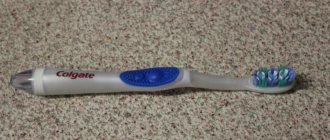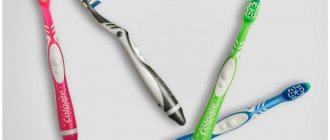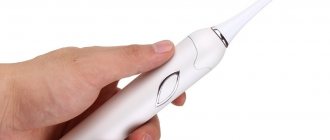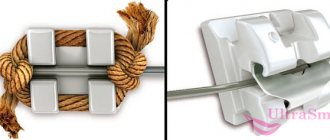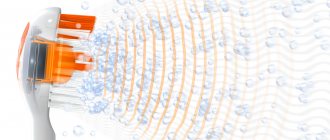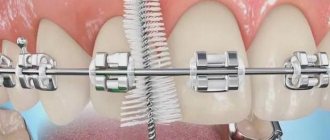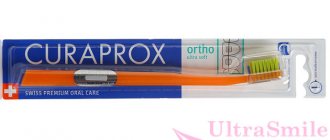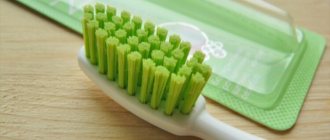A snow-white smile and the absence of bad breath allow us to create the first impression of our interlocutor.
But how to properly care for your teeth so that they look perfect if your oral health is far from ideal?
First, you should go to the store and buy a toothbrush that will effectively cope with its task and will not scratch the enamel .
Today we’ll talk about how to choose the right hygiene tool with soft bristles.
Distinctive features of a soft toothbrush
Keep in mind! If you are an adult with dental problems: a soft toothbrush is what you need.
The plastic bristle gently cleanses the enamel without causing discomfort or provoking inflammatory complications.
However, such bristles cannot penetrate the narrow interdental spaces .
The product marked soft or medium has a stiffer bristle and is suitable for people with a healthy oral cavity.
In any case, you can use dental floss to clean hard-to-reach areas .
Vinegar
Many people soften their paint brushes by soaking them in vinegar. If this method softens paint brushes, then it will work for toothbrushes. Another method to make your toothbrush soft is to soak it in a vinegar solution or pure vinegar. Any will do - table, apple or wine. But, as a rule, most people have a regular dining room in their kitchen.
How to do it?
- Vinegar is poured into a vessel (preferably transparent). You don't need a lot - just enough to completely hide the stubble.
- The dishes are placed in the microwave and heated - it is not necessary to boil, just make the liquid warm.
- Dip a brush into vinegar and leave for half an hour.
- After the appointed time, the brush is pulled out and rinsed under running water.
- To achieve a better effect, the bristles can be kneaded with your hands.
Indications for using a soft bristle brush
This hygiene item is not suitable for everyone, and in some cases it does not fully do its job.
It is worth noting! Soft dental appliances are ideal for:
- babies learning to care for their first teeth;
- children during the period of replacement of milk teeth with permanent ones (10-12 years);
- people with poor blood clotting (diabetics);
- adults with sensitive, easily damaged enamel ;
- people with various oral diseases (periodontitis, gingivitis, stomatitis, periodontal disease);
- patients with tooth mobility syndrome.
Also, a soft toothbrush is ideal for adults with a history of erosive lesions or wedge-shaped defect .
Dentists recommend buying soft toothbrushes for children under 10 years of age.
This is due to the imperfection of dental tissues and the vulnerability of the mucous membrane.
Hard fibers can cause damage, leading to more serious consequences.
For older people, a soft-bristle toothbrush is ideal..
Know! Over time, the body wears out, and this directly affects the gums: they become loose and bleed at the slightest damage.
Mouthwash
Take a clean glass and fill it with mouthwash. There is no need to fill to the top. The main thing is that when you lower the brush there, the bristles are completely hidden. You can even soak old brushes that you haven’t thought about for a long time and that have already dried out in this way.
Mouthwash
Personally, I tried this method on myself. I had a couple of brushes lying around at home that I took out of boxes and forgot. They weren't used, so I didn't throw them away. I took about 100 ml of liquid, poured it into a cup, and left the brush in it until the morning. Honestly - just like in advertising - soft and comfortable.
Using mouthwash
How to determine hardness by marking?
For the convenience of the consumer, the manufacturer labels its product in a certain way.
To choose a product with soft pile, it is not necessary to determine its hardness to the touch.
Guided by labeling , and not appearance, dental care item
- Sensitive . A device with this marking is equipped with very soft bristles . It gently removes plaque without damaging tooth enamel. Suitable for young children or adults suffering from periodontal disease. A soft brush is also good for cleaning sensitive teeth. However, you should consult your dentist before use.
- Soft . This product is suitable for elderly people and diabetics. They are also recommended for use by patients with oral diseases and pregnant women with gingivitis. It is important to use the instrument using a special technique that eliminates pressure on weakened tissues.
- Medium. This marking indicates medium-hard bristles . Well suited for people with healthy teeth.
- Hard. Model with stiff bristles : good for experienced smokers and coffee lovers. It is effective in removing dark stains on teeth, but is not suitable for daily use. If your teeth are sensitive, it is strictly forbidden to use it.
- Extra-hard. Products with similar markings are designed for cleaning dentures , bridges and braces. Such hard bristles can cause irreparable harm to living teeth.
Stay up to date! Knowing the meaning of each marking when choosing a brush that is suitable for your teeth will not be difficult and will save time.
Studying the material of the toothbrush
In the manufacture of modern toothbrushes, synthetic materials are usually used. You can also sometimes find brushes made of natural bristles. At first glance, it may seem that a “natural” brush is much better, but this is not at all the case. Brushes made of natural bristles are unhygienic, as bacteria can multiply inside the hairs, and this contributes to the development of inflammatory diseases of the oral cavity.
Another disadvantage of natural bristles is their fragility. After the hair breaks, a sharp edge remains, which can injure the gums. There is no way to round off these ends. In addition, natural bristles strongly absorb moisture, which also promotes the growth of bacteria in them. Another disadvantage of a bristle brush is that it is too soft. Such a brush will be very poor at removing plaque, so cleaning will be ineffective.
The world's first toothbrush appeared about 500 years ago in China, and it was made from pig bristles, badger and horse hair.
Choosing a toothbrush is one of the rare moments when you should not give preference to a natural product. In all respects, brushes made from synthetic materials are better than natural ones. Only people with allergies to synthetic materials should choose natural brushes.
Kinds
Today there are several types of brushes for delicate dental care.
Each type has its own advantages and disadvantages . In any case, the choice remains with the consumer.
Regular
The length and shape of the ends of the pile and the number of tufts are an important selection point.
Sharp bristles are suitable for removing plaque in hard-to-reach places , but people with fragile enamel and weakened gums should not buy them.
Dental appliances labeled soft or sensitive are the right choice in this case. Their soft bristles are rounded and avoid scratching.
Note! For daily dental care, it is better to choose a soft brush with frequent bristles.
Combined
These dental instruments are available both conventional and electric. Their heads are equipped with soft bristles on one side and hard (elongated) bristles on the other.
Products of this kind are quite
effective and at the same time practically safe.
Electrical
They have an original design and are multifunctional .
Under the influence of current, the head of this model rotates intensively, which allows you to effectively remove plaque without driving it under the gum .
However, electric toothbrushes can damage sensitive enamel and gum tissue . To prevent this from happening, the kit comes with a nozzle with soft bristles.
When the heads wear out, you can replace them with new ones.
Ultrasonic
Know! These toothbrushes are similar in appearance to electric ones. They are a new word in technology and have not yet become widespread.
The impact occurs due to low-frequency wave vibrations, which effectively remove the oldest plaque.
Ultrasonic attachments
are strictly contraindicated for: pregnant women , people with neoplasms in the oral cavity, persons with impaired keratinization of the mucous epithelium .
Ionic
Brushes of this kind have appeared quite recently. The operating principle is based on the rotation of a rod coated with titanium dioxide molecules.
When it reacts with liquid (saliva), the substance attracts hydrogen ions . are the ones who kill pathogenic bacteria and eliminate the acidic environment.
An ionic toothbrush allows you to save on the purchase of toothpaste.
Important to remember! It is contraindicated for smokers: nicotine, which reacts with hydrogen ions, has a destructive effect on the mucous membrane.
For cancer patients, as well as people with oral fluid deficiency syndrome, the use of this brush is not recommended.
Features of the location of the bristles
More than half a century ago, people used toothbrushes made from both natural bristles and synthetic fibers. Now scientists have proven that it is permissible to use only products with artificial bristles, because a natural brush absorbs moisture, and this provokes the growth of microorganisms. The end part of the villi is always rounded so as not to scratch the surface of the enamel and soft tissues of the oral cavity. Nylon bristles are grouped in tufts, which are arranged in various ways along the surface of the plastic head. According to the height of the pile, brushes come with a single-level arrangement of elements, two-, three-, and also multi-level.
The beams are fixed to the site in a special way, and can be installed both parallel to each other and at different angles. The difference in location allows for more complete cleansing of all tooth surfaces.
How to make it soft at home?
If you accidentally purchased a hard toothbrush that doesn’t suit you and causes a lot of discomfort, you can soften it in several ways:
- Through hot water. To do this, you need to hold it under running water at 40-50˚C or soak it in a glass. Steep boiling water is not suitable for this purpose, as the synthetic bristles may melt and the brush will become unusable.
- Hydrogen peroxide. This method is the fastest and most effective. To do this, you need to put the toothbrush in a glass with a 3% peroxide solution so that it covers the head with the bristles. After 5 minutes, you can take it out and rinse it with running water and safely use it.
- Aloe Vera gel. This product effectively softens the skin and can be used with a toothbrush for the same purpose. The method of application does not differ from the version with hydrogen peroxide, however, it should be kept in the gel for at least 10 minutes.
- Tooth rinse. These hygiene products have antibacterial properties and will also help soften the hard bristles of your toothbrush. The components contained in the rinse aid can restore old, dried out fibers. To do this, you need to fill the glass halfway with the product, lower the toothbrush into it and wait the required amount of time. The hardest pile becomes soft in half an hour.
Hot water will make the brush softer
The easiest and most affordable option to soften bristles is to use hot water. There are several algorithms, choose the most convenient and accessible:
Open the hot water tap and place the stiff bristles directly under the stream for 7-10 minutes. To avoid burning your hands, hold the tool by the handle and be careful. Pour hot water into a deep container (glass, bowl) and place the hygiene device there with the cleaning head down. It will take at least five hours to soften the bristles in this way, and it is important to ensure that the water does not cool down. To do this, you will have to constantly add hot liquid to the container.
Note that hot water does not equal boiling water. Boiling water will also soften the bristles, but at the same time it can lead to their deformation and melting of the plastic elements of the cleaning head.
Review of the most popular models
You should know! There are many high-quality toothbrushes on the modern consumer market.
Here are the most popular models equipped with soft bristles:
- Exceed by Oral-B. Polyamide bristles are arranged in a special way, which allows them to penetrate into the most difficult to reach places. On the back of the head there is a special surface for cleansing the mucous membranes of the cheeks and tongue. The handle has rubberized inserts for ease of use.
- SPLAT Professional Sensitive. The bristles on this brush model have rounded ends and are divided into 4 parts. This eliminates injury to weakened gums and sensitive tooth surfaces. Each fiber is treated with silver ions, which has a disinfecting effect. This brush delicately removes plaque without scratching the cavity tissues.
- LACALUT Sensitive. The pile of this model is made of nylon threads impregnated with silver ions. The rounded bristles do not scratch the enamel and do not injure the gums. This brush is ideal for young children and people with sensitive teeth.
- Colgate 360 SensitivePro–Relieve. This model is equipped with the finest bristles, between which there are rubber cups. This allows you to gently clean and polish your tooth enamel. The elongated bristles penetrate into the interdental spaces and remove the smallest particles of food. On the back of the head there is a soft brush for cleaning the tongue, which reduces the growth of pathogenic microorganisms in the mouth.
- Jordan Target Sensitive. The thickness of the bristles of this model is only 0.01 mm, which allows them to effectively clean even the back surface of the teeth. The brush is good for people with various oral diseases and those who wear braces. The compact and ergonomic handle is comfortable to hold during use.
- Silka Favorite. It is distinguished by its versatility due to the originality of its design. Two-level nylon bristles allow for thorough cleaning of the gingival groove, gently massaging the gums, and the beveled lower fibers carefully remove plaque. There is a special ledge for hard-to-reach areas. The handle has a thumb ridge.
Remember! If you suffer from oral diseases and want to purchase a special toothbrush: be sure to consult your dentist.
Electrical Products
Electrical products used for oral hygiene have recently been in great demand; an increasing number of people are trying to acquire “vibrating leaders” for themselves. But in fact, their popularity is not particularly supported by anything. They remove plaque from the surface of the teeth a little better than the manual ones we are used to, but there is a risk of damage to the fillings, crowns and other prostheses present in the mouth; over time, they become loose. In addition, massage of the gums with a mechanical toothbrush must be done not while it is vibrating, but in the off state, which can be done with a regular brush.
All hygienic electrical appliances are divided into:
- classic options that are equipped with a rotating element;
- sound, they are characterized by their oscillatory effect when cleaning the surface of the teeth;
- ultrasonic models that produce strong vibrations.
Symptoms and types of tartar
The appearance of tartar on teeth may be indicated by:
- dark spots on the enamel;
- bad breath;
- redness or blueness of the gums;
- bleeding when brushing teeth;
- inflammation of the gums, which begin to manifest as itching and pain.
At the initial stage, tartar forms around the neck of the tooth , and looks like a brown or yellow rim, which over time spreads to the crown and into the periodontal pocket. There are:
- Supragingival calculus. It has a clay-like consistency and is clearly visible. It can be easily removed using dental instruments.
- Subgingival. Outwardly invisible and detected only after dissection of the gums. It feels dense and hard to the touch.
Ignoring the problem can lead to inflammatory diseases of the oral mucosa and the development of caries. Bacteria formed under the stone release toxins that are absorbed into the blood and spread throughout the body, which contributes to the exacerbation of various chronic diseases.
Recommendations when choosing
There is a wide variety of brushes, so to choose the right product for yourself, consult your dentist.
Simple rules will also help you make your choice:
- choose a brush with artificial bristles, it will last longer and will not contribute to the growth of bacteria on the bristles,
- the standard length of the head is 2.5-3 cm - this is the optimal size for an adult,
- pay attention to the end of the bristles - it should be smoothly rounded so as not to cause injury,
- If the dentist has not prescribed a specific type of brush, then buy a product of medium hardness, because too hard bristles can scratch the enamel, and soft bristles will not remove soft deposits well.
Pastes for removing plaque and polishing teeth –
To remove small tartar and pigmented plaque, we can use 2 groups of products. Firstly, there are some whitening toothpastes that are highly abrasive. The second option is that you can purchase a special paste for polishing teeth in a specialized store that sells consumables for dental clinics (this option is much more effective, and you can even place an order online).
The advantage of the first option is the high availability of whitening toothpastes (list below), but their capabilities will be much more modest when compared with professional polishing paste for removing plaque and plaque. Below we will talk in more detail about each option.
Detartrine Z polishing paste –
Professional polishing pastes “Detartrin” and “Detartrin Z” do an excellent job not only of smoker’s pigment plaque, but also even of small dental deposits. The second version of this paste is especially effective, containing specially sharpened zirconium granules that can remove dental plaque and smoker’s plaque without damaging the enamel (24stoma.ru). In addition, the paste contains essential oils, leaving a long-lasting feeling of freshness in the mouth. Production – (France).
Pastes “Detartrine” and “Detartrine Z” –
The paste is taken from the tube only with a clean spatula and applied to the bristles of the working head of the Oral-b brush. Next, you need to “spread” the paste over several teeth, then turn the brush on at low speed, and treat each tooth for 10-20 seconds (more precisely, as needed). After treating your teeth, you need to rinse your mouth thoroughly several times. Use no more than once a week. The cost of a 45 mg tube of “Detartrine Z” in different stores can range from 1,600 to 2,800 rubles.
There is also another version of this paste - the usual “Detartrine” without zircon. It is a little cheaper, but also copes somewhat worse with, for example, the smoker’s residue. But in any case, both versions of this paste are much more effective at removing pigmented plaque and dental plaque than most other similar products (i.e. similar polishing pastes from other manufacturers).
Toothpaste “PRESIDENT PROFI PLUS White Plus” –
controlled abrasiveness – RDA 200 ,- abrasive and polishing components (silicon dioxide, calcium carbonate, diatomaceous earth, titanium dioxide),
- applied only once a week,
- price 30 ml - about 260 rubles.
It is necessary to apply a small amount of paste to a group of several teeth, and then use the Oral-b toothbrush at low speed, for example, in the “Whitening / Polishing” or “For Sensitive Teeth” modes. The effectiveness of PRESIDENT White Plus will be lower than Detartrine Z.
Toothpaste “LACALUT White” –
controlled abrasiveness – RDA 120 ,- abrasive and polishing components (hydrated silicon dioxide and titanium dioxide),
- benefits – contains pyrophosphates and sodium fluoride,
- fluoride content: 1357 ppm,
- together with an electric brush can be used once every 2 days,
- price: 50 ml – from 250 rub., 75 ml – 350 rub.
The effectiveness of this paste will be significantly lower than the previous ones. And she can only help you with a small amount of not too pronounced pigmentation. Apply according to the same principle as previous products (together with an Oral-B electric brush).
A few additional recommendations -
The cost of a good Oral-B electric brush starts from 2700-3500 rubles (at this link you can read our review on the optimal choice of models). You can even buy “Detartrine Z” or “Detartrine” polishing paste in traditional online stores, but it will be cheaper to do it in those organizations that sell consumables for dental clinics. There are many such companies in every city. And I would like to say a few more words about the selection of toothpaste for daily use in the morning and evening.
It is advisable that in patients with a high rate of tartar formation, such a paste contains polydon or pyrophosphates (these components significantly reduce the rate of mineralization of soft microbial plaque and its transformation into hard tartar). Polyphosphates (for example, sodium hexametaphosphate and trisodium phosphate) can significantly reduce the adhesion and deposition of microbial plaque.
Another useful components are the proteolytic enzymes bromelain and papain. They help loosen the already formed tightly attached microbial plaque, which certainly contributes to its removal by the abrasive components of toothpastes. In addition, it is desirable to contain sodium fluoride or amino fluoride in the paste, and in a concentration of at least 1400 ppm. The fact is that fluoride has a bactericidal effect, suppressing the vital activity of microorganisms, thereby preventing an increase in the volume of microbial plaque in the oral cavity.
Well, in the next section we gave several examples of techniques that are recommended for removing tartar at home - on various thematic sites and forums. You might be interested in reading this nonsense.


